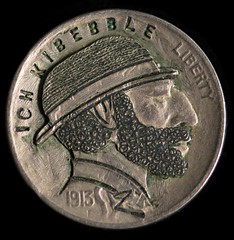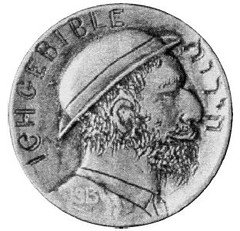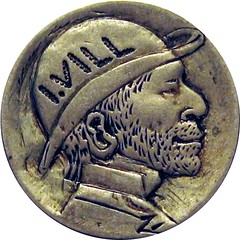
PREV ARTICLE
NEXT ARTICLE
FULL ISSUE
PREV FULL ISSUE
MORE ON HOBO NICKELS AND ETHNIC SLURSLast week Bob Leonard wrote: The ethnic slur nature of the original "hobo nickels" has been swept under the rug by modern collectors, but it is established by the existence of pot metal tokens imitating this design on the obverse, with the pawnbroker's three balls on the reverse.
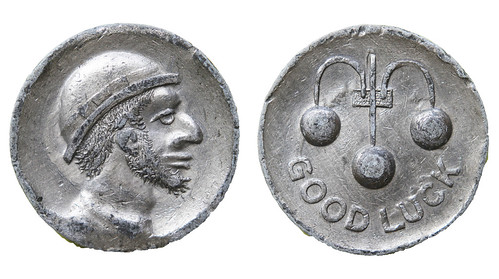
Bob Van Arsdell provided the above image of the piece referred to. He provides the dimensions as:
Weight: 6.7419 gms
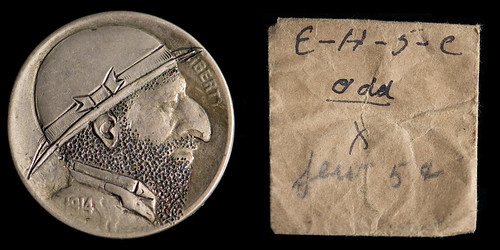
Alex Lynn writes: I read with some interest last week's discussion of "sheeny" nickels. I am a first time contributor to the discussion here, and feel a bit 'funny' that my first contribution would be around an unpleasant subject. Attached are images of two examples of "sheeny" nickels from my own collection. The first is on a 1914 Philadelphia nickel, and is accompanied by an image of the old (I believe 1940's) homemade collection envelope that it was in when I acquired it. The notation on the envelope leaves no question as to the ethnicity of the intended subject, and how that rendering was perceived back in the 40's.
Both examples are submitted only for the sake of discussion and furthering understanding of this unpleasant tradition within the field of carved coins. I've puzzled over both of them for some time, and am interested to see what other examples readers are able to turn up.
Thanks for your submission. For those who can't read the pencil notation on the envelope, it says "Jew 5¢". I'm old enough to have heard "Ich Kibebble" , but never knew what it meant. Interesting to see another "Ich Kibebble" Hobo nickel.
-Editor
Alex adds: I heard the "Ich Kebibble" name a few times too, when I was very young, but didn't have much background info at the time. I've wondered if the phrase was understood as mock-Yiddish at the time of the "Isch Ga-Bibble" song's initial popularity, ca. 1913, or if that emerged later? In context of the song's original lyrics, it just seems like pure nonsense, but that was now a century ago, in a different world, almost. Probably a good question for a historian of popular song. Yossi Dotan writes:
In Hebrew BOTH חירות and חרות are acceptable spellings, just like through and thru in English. Instead of a misspelling, I guess that the creator of the carving used a longer Hebrew word to fill up the space originally taken up by the word Liberty. Marvin Tameanko writes: I am older than most of your readers so should mention that Ish Kabiibble (correct spelling) was a coronet player named Merwyn Boque in Kay Kyser's swing orchestra (1940-50's) He clowned around on stage as well as played his instrument and was a well-liked character in Kyser's TV show in 1949-50, Kay Kyser's Kollege of Musical Knowledge. He was not Jewish. Ron Thompson of Decatur, GA writes: I’m always amazed at the quantity and quality of the weekly E-Sylum. How you keep it up is beyond me, but bless your heart –Thank you! Regarding the Hobo Nickels and Ethnic Slurs article, as a medal collector I am amazed how people can discern motives from a few design elements. The comments reminds me of the art experts who try to tell you about the motives and meaning of art. I think the interpretations tell as much about the interpreter as they do about the art. I don’t see how the statements made about the ethnic slur nature of the item can be supported without knowing more about the artist and what he or she said about it.
That aside, I would agree that the I VILL means I WILL but rather than a slur just against the Jewish folks, in particular, I think it might be a comment about the German people in general. Remember there was WWI and WWII with Germany. Germans, in general, were not popular here at the time this hobo nickel was probably created. Also German Jews were not the only ones to have that language affliction as most people who grew up in Germany that came here had it. My Mom was born in the United States and was an American citizen her whole life, but her parents were from Germany and her father was recalled to Germany for WWI, so she grew up in Germany as a Roman Catholic. She came back to the US in the 1930s but until she died in the 1980s, as much as she tried, her W's came out as V's. So what does it mean? Who knows? You either like it and find it interesting or you are on to the next one in your collector quest.
The "Jew 5¢" envelope notation indicates how that coin was seen by at least one collector. As for the "I VILL" piece, we may never know the intentions of the carver. Thanks, everyone. Interesting topic, and thanks for the great images.
-Editor
To read the earlier E-Sylum article, see:
HOBO NICKELS AND ETHNIC SLURS
(www.coinbooks.org/esylum_v17n23a15.html)
The Numismatic Bibliomania Society is a non-profit organization promoting numismatic literature. See our web site at coinbooks.org. To submit items for publication in The E-Sylum, write to the Editor at this address: whomren@gmail.com To subscribe go to: https://my.binhost.com/lists/listinfo/esylum All Rights Reserved. NBS Home Page Contact the NBS webmaster 
|
